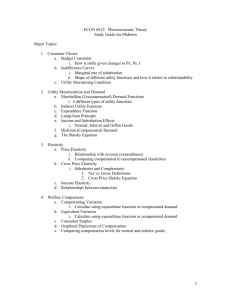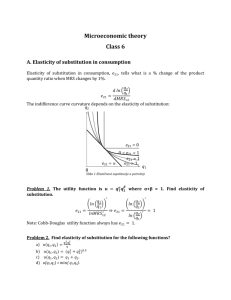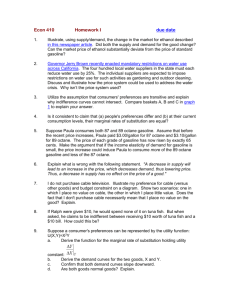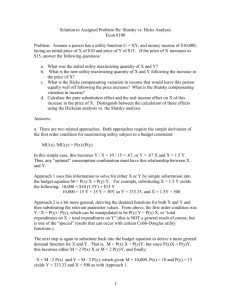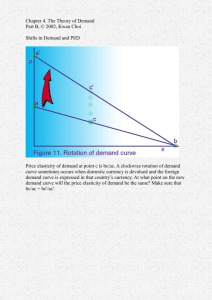Microeconomics Theory
advertisement
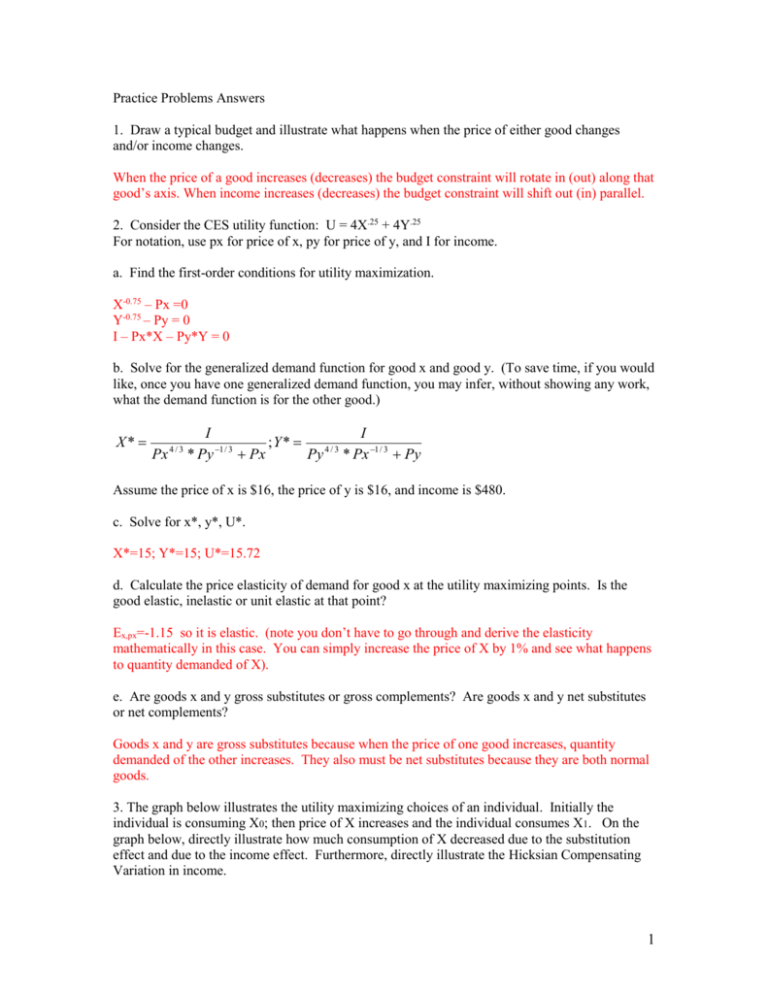
Practice Problems Answers 1. Draw a typical budget and illustrate what happens when the price of either good changes and/or income changes. When the price of a good increases (decreases) the budget constraint will rotate in (out) along that good’s axis. When income increases (decreases) the budget constraint will shift out (in) parallel. 2. Consider the CES utility function: U = 4X.25 + 4Y.25 For notation, use px for price of x, py for price of y, and I for income. a. Find the first-order conditions for utility maximization. X-0.75 – Px =0 Y-0.75 – Py = 0 I – Px*X – Py*Y = 0 b. Solve for the generalized demand function for good x and good y. (To save time, if you would like, once you have one generalized demand function, you may infer, without showing any work, what the demand function is for the other good.) X* Px 4/3 I I ;Y * 1 / 3 4/3 * Py Px Py * Px 1 / 3 Py Assume the price of x is $16, the price of y is $16, and income is $480. c. Solve for x*, y*, U*. X*=15; Y*=15; U*=15.72 d. Calculate the price elasticity of demand for good x at the utility maximizing points. Is the good elastic, inelastic or unit elastic at that point? Ex,px=-1.15 so it is elastic. (note you don’t have to go through and derive the elasticity mathematically in this case. You can simply increase the price of X by 1% and see what happens to quantity demanded of X). e. Are goods x and y gross substitutes or gross complements? Are goods x and y net substitutes or net complements? Goods x and y are gross substitutes because when the price of one good increases, quantity demanded of the other increases. They also must be net substitutes because they are both normal goods. 3. The graph below illustrates the utility maximizing choices of an individual. Initially the individual is consuming X0; then price of X increases and the individual consumes X1. On the graph below, directly illustrate how much consumption of X decreased due to the substitution effect and due to the income effect. Furthermore, directly illustrate the Hicksian Compensating Variation in income. 1 Y U0 U1 X1 X0 X To find income in substitution effects shift out the new budget constraint until it is tangent to the original indifference curve. Call this new tangency point X2. The difference between X1 and X2 is the income effect. The difference between X2 and X0 is the substitution effect. The difference between the original Y intercept and the new intercept equals the HCV. 4. On the graph below, depicting the same situation directly illustrate the Hicksian Equivalent Variation in income. Y U0 U1 X1 X0 X To find Hicksian Equivalent Variation take the old budget constraint and shift it in until it parallel to the new indifference curve. The difference between the original Y intercept and the new intercept equals the EV. 2 4a.) Does the graph above depict a normal or inferior good? Are good X and Y substitutes or complements? Normal. The consumption of Y doesn’t change much when the price of X changes, but if anything it appears Y decreases slightly, so they would be complements. 5) A student spends 8 hours per day listening to music, with M hours devoted to Mozart, and B hours devoted to Beethoven. The student’s utility function is given by U=M0.25B0.75 Explain whether the following statement True, False, or Uncertain: The utility maximizing listening pattern of this student will generate four times as much listening to Beethoven as listening to Mozart. U 0.25M 0.75 B 0.75 B MRS = M 0.25 0.25 U 0.75M B 3M B B Given that the MRS is it is obvious that the optimal listening pattern will generate 3 times as much 3M listening to Beethoven as Mozart, not 4. Therefore this statement is false. 6) Suppose currently Sophie consumes 15 units of X and 12 units of Y. The price of X is $3 and the price of Y is $6. Her current marginal utility of X is 21 utils. a.) If she is currently maximizing utility, what is her marginal utility of Y? MUx/Px = MUy/Py ; 21/3 = MUy/6 ; MUy=42 b.) What does her marginal utility of income equal? MUI = MUx/Px = MUy/Py = 21/3=42/6=7 7) Assume that utility is given by U=X0.3Y0.7 a.) Calculate the indirect utility function. x 0.3I px , y 0.7 I p y , U .3.3 .7.7 Ipx.3 py.7 BIpx.3 py.7 b.) Calculate the expenditure function. E = B1Up.3x p.7y . c.) Calculate the compensated demand function. The compensated demand function is xc E / p x .3B 1px.7 p.7y . 8) A hot dog vendor faces a daily demand curve of Q=1800-15P, where P is the price of a hot dog in cents and Q is the number of hot dogs purchased each day. 3 a) 300= 1800 – 15P, so P = 100, which gives TR = 100(300) = 30,000 cents/day = $300/day b. What is the price elasticity of demand for hot dogs? Expressing the demand curve in terms of price, we have P 120 Q 15 P 1 Q slope Price elasticity = (1/3) ( -15) = -5 c. The vendor decides that he want to generate more revenue. Should he raise or lower the price he charges for hot dogs? Since demand is elastic with respect to price, a reduction in price will increase total revenue. d. At what price would he achieve the maximum total revenue? Maximum total revenue occurs where price elasticity = -1 P 1 P Q = 15 1 , to maximum TR will occur when P 15 Q slope Q Q back into the demand curve, we get 15 Substituting P Q Q 120 or, 15 15 2 Q 120 , Which solves for Q = 900. At Q = 900, we have P = 60. 15 Note that the revenue maximizing point, Q=900, P=60, corresponds to the midpoint of the demand curve, which will always be the case with a linear demand curve. 9. Suppose the price of oil suddenly rises from $100/barrel to $110/barrel. As a result, total expenditures on oil increase from $300 million/day to $320 million/day. What is the price elasticity of demand for oil? At a price of $100/barrel, the quantity sold equals 3 million ($300 million/$100/barrel). At a price of $110/barrel, the quantity sold equals 2.91 million ($300 million/$110/barrel). Therefore, the price elasticity of demand equals (-.09/3)/($10/$100) = -.30. 10. List and briefly explain whether the following good X is Normal, Inferior, a Giffen good, or Indeterminate. a.) The price of good X increases from $30 to $35. Uncompensated demand changes from X 0 80 to X 1 =75. Compensated demand changes from X 0C 80 to X 1C =76. 4 The quantity demanded along the uncompensated decreased by more. Therefore the income effect is working in the same direction as the substitution effect and it is a normal good. X C b.) 0 PX This is simply saying that the substitution effect is negative as price increases, which is true for all goods. Therefore it is indeterminate. c.) Price increases, and the Hicksian Compensating Variation is less than the change in Consumer Surplus. This is true of inferior goods, because the income effect will be operating in the opposite direction of the substitution effect. 11. Describe in words what the Compensating Variation for a price increase is and how to find it. Do the same for the Equivalent Variation. The Compensating Variation is the amount of income an individual must be given after the price increase to reach their original utility level. This is the amount they are willing to accept for the price increase. To find it you plug in the original utility level and new prices into the individual’s expenditure function. The difference between this amount and their original income level is the Compensating Variation. The Equivalent Variation is the amount of income that must be taken away from an individual before the price increase to reach their new utility level. This is the amount they would be willing to pay to avoid the price increase. To find it you plug in the new utility level and original prices into the individual’s expenditure function. The difference between this amount and their original income level is the Equivalent Variation. Y X X C 0 .1 ; X * 0.15 0.2 ; Y * I I PY a.) Is X a gross substitute or complement of Y? How do you know? 12. Suppose: X <0. PY b.) Is X a net substitute or complement of Y? How do you know? X C It is a net complement because <0. PY c.) Is X a normal or inferior good? How do you know? X It is inferior because <0. I Y d.) What does equal? Px It equals -0.2 - 0.15 = -.35 It is a gross complement because 5
